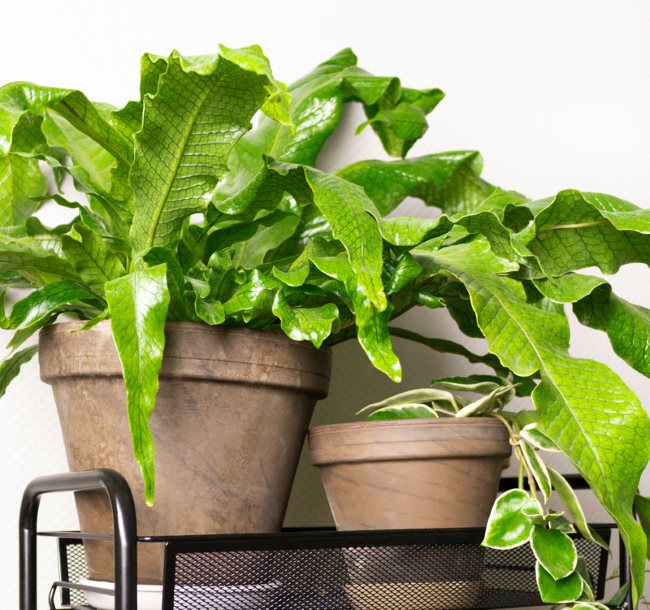
Botanical Title: Microsorum musifolium ‘Crocodyllus’
Crocodile Fern has shiny, brilliant inexperienced fronds in a charming croc sample, making this tropical fern irresistible as a houseplant. Happily for us, it is also one of many best forms of ferns to develop indoors.
This Aussie native grows as an epiphyte (a plant that grows on timber) within the heat, moist, tropical rain forests. Regardless of its tropical beginnings, Crocodile Fern adapts nicely to being a home plant.
Place your potted fern the place it’s out of direct solar and away from drafts, which may scorch the fronds. Enhance humidity and you may maintain it wholesome and thriving for a few years.
Crocodile fern grows in a whorl of vibrant, deeply veined, spear-shaped fronds, which attain about 2 ft (60 cm) in size. Put this eye-catching fern on a plant stand or in a dangling basket to indicate it off.
Crocodile Fern Issues, Options and Solutions
As Crocodile Fern ages, the oldest, outer fronds will flip brown. That is regular. You’ll be able to reduce them off to maintain your plant trying its greatest. Scorching, dry air may trigger fronds to brown. Boosting humidity round it helps.
These upright fronds are usually dust-catchers. Hold the broad, shiny fronds dust-free by gently wiping them with a moist fabric. By no means use leafshine merchandise on ferns as a result of it could severely injury their delicate fronds.
Repot younger vegetation in spring, each couple years or when the roots fill the pot. For those who discover that the roots are connected to the pot, run a knife across the inside to loosen them earlier than you’ll be able to take away the rootball. You might want to interrupt the pot to take away it. It is a good suggestion to use a container with drainage holes to keep away from soggy soil. Take care to not pack down the potting combine. An epiphyte in its native habitat, this fern likes a unfastened combination.
Not many pests trouble this fern. Look ahead to scale bugs, that appear to be small, brown discs on fronds. For those who discover an invasion of those pests, spray with soapy water adopted by clear water. Do not use pesticides on ferns as a result of they’re simply broken by chemical substances.
Is Crocodile Fern cat-friendly? Sure, it isn’t toxic, so you’ll be able to safely develop this fern indoors round your pets and children.
Crocodile Fern Care Suggestions
Origin: Tropical Australia
Peak: Fronds can attain 2-3 ft (60-90 cm) lengthy when grown in a container indoors.
Mild: Give your plant brilliant, oblique daylight. No direct solar, which may scorch the fronds. Give the pot 1 / 4 flip every week for even development. If you do not have a spot in entrance of a window, a develop mild works splendidly.
Water: Water evenly, but typically to maintain potting medium moist, however not soggy. Underneath-watering will trigger the fern to wilt, however an excessive amount of water could cause roots to rot and fronds to show yellow. Water much less in winter when development is slower. Keep in mind to at all times use room-temperature water for watering tropical houseplants; chilly water is a shock to them.
Humidity: Give this tropical fern moist air. If the relative humidity drops under 50%, use a humidity tray or cool-mist room humidifier so as to add moisture to the air across the fern. Indoor air can grow to be extraordinarily dry in the course of the winter months; it is a good suggestion to make use of a humidity gauge moderately than guess. Brown leaf suggestions are a symptom of dry air.
Temperature: Common room temps (65-75°F/18-24°C) will swimsuit this tropical fern. Hold your plant away from warmth/AC vents, which may be drying to ferns.
Soil: Peat moss-based potting combine is good for this fern. Depart that miracle combine on the shelf — all that in-built fertilizer is an excessive amount of for ferns delicate roots.
Fertilizer: Feed each 2 weeks in spring and summer time with a balanced (reminiscent of 10-10-10 NPK) water-soluble fertilizer at half the quantity really helpful on the package deal. Feed each couple months in fall and winter, when development is slower. This fern just isn’t a heavy feeder — it is roots can undergo from chemical burn from an excessive amount of fertilizer.
Propagation: M. musifolium grows from semi-woody, branched rhizomes that may be divided in spring and potted individually. Do not bury them; cowl rhizomes with about 1-inch of potting combine.